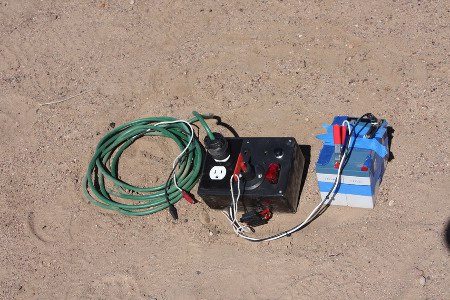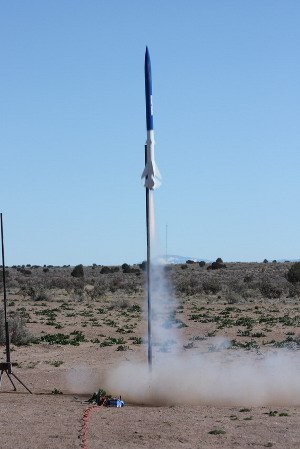

ROCKETRY IS AN INHERENTLY DANGEROUS ACTIVITY. I CANNOT BE HELD RESPONSIBLE FOR YOUR ELECTING TO USE THIS CONTROLLER AND HAVING AN ACCIDENT OR DEATH WHILE SO ENGAGED. BY USING THIS LAUNCH CONTROLLER DESIGN, IN PART OR IN WHOLE, YOU AND YOU ALONE TAKE FULL RESPONSIBILITY FOR YOUR ACTIONS AND AGREE TO HOLD NO ONE ELSE RESPONSIBLE FOR ANY CONSEQUENCES.
Overview;
With the opening of our club's new private research field a couple of hours' drive away, the need for personal launch equipment became a requirement as the club's trailer would be left in storage for these launch dates. Our club's superlative launch controller system, designed by Ken Goldstein and Tony Lazarro, would be left behind along with the pads and other heavy equipment. I wanted to be able to use something as capable, safe, and as simple as Ken and Tony's design.
A quick look through the offerings on the internet turned up many useful designs that although functional did not offer up the same level of safety and ease of use that what I was looking for in a design. None of them seemed to offer anything other than the most basic of cabling and system diagnostics in case something wasn't right. And a lot of them required a battery at both the Remote Unit at the LCO position and at the Relay Unit at the Launch Pad position. Most of all I wanted a HPR launch system that didn't require that I give up ANY of the continuity or safety features of the average model rocket launch system.
I came up with this design over the course of a few nights playing with Xcircuit. I choose the name 'elegant" as this controller is what an engineer would refer to as an 'elegant design'; It contains no extra parts to achieve the 'Design Goals' and is a simple yet fully functional design. Even inexperienced rocketeers can tell from the alert sounds when some switch is in the wrong postion or there isn't continuity.
Two units have been built to date using the just the circuit schematic by experienced engineers. They have been used at at least ten launches on a variety of high power, mid power, and low power rockets without any surprises. Both have worked correctly and went together quickly. I have included additional information on this web-site to make it easy for anyone with basic rocketry construction skills to complete this project.
The information on this web-site is copyrighted and I reserve all rights to this design. However you are free to make one and use it for your own amusement.
Credits and Help;
Good results are seldom the efforts of one person and this undetaking is no exception to that rule. I would like to thank the people that helped me along the way to completing this work;
Ken Goldstein and Tony Lazarro's club launch controller system was a tour-de-force in elegant design and an inspiration to my efforts. Their un-selfish sharing of the information and schematics are benefits to the club. The equipment has been both durable and to the point.
Bill Beggs for encouraging me to get involved in any way that I can with the club. Sometimes he regrets this, but that is wholly my fault.
Nathan Dalrymple for willing to be a guinea pig and build the second (beta) unit. He didn't even hesitate a second and was a great partner during this project. He is also a great photographer and is credited with the construction photos.
Kevin Small for helping me with photos and early testing on a very inhospitably cold launch date in February. I did all the complaining, (He did none.)
Jim Sauer for seeing the merit of this design and asking to get involved with building a third unit. His interaction with his middle school students and what he achieves with them is a source on continual wonderment to me. Jim also has given me good feedback on part sourcing issues.
Dave Founds with the Air Force's Research Labs (AFRL) at Kirkland Air Force Base for his effusive praise of this launch controller design. He is the reason the information is being made available here.
Ronda Cole for helping me continue my interest in rocketry by insisting that I develop a teaching curriculum of my own instead of using her work at the AFRL's La Luz Academy. She had faith in me and it was welcomed.
|

 The
The
 The
The